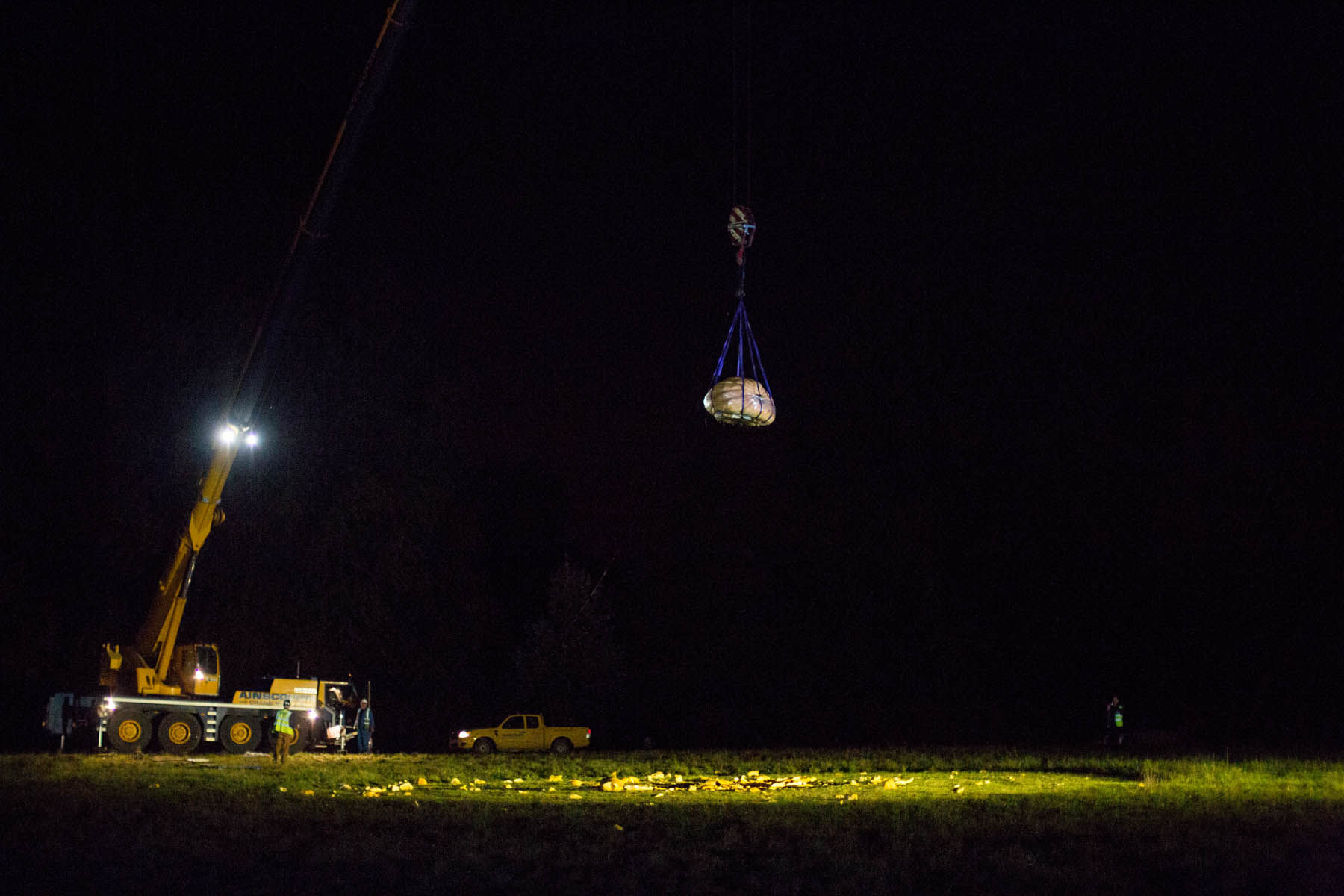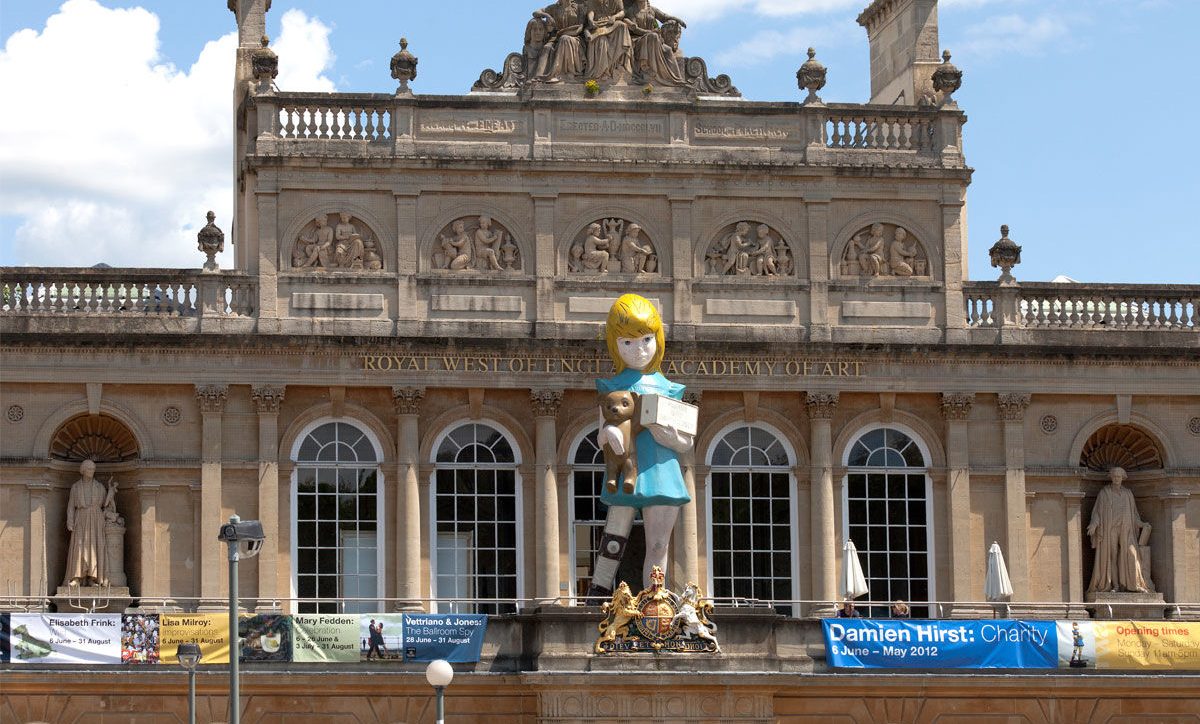
Synopsis
From June 2011 to May 2012 The Royal West of England Academy hosted Damien Hirst’s work ‘Charity’ a monumental sculpture based on 1970’s Spastic Society collection box. Standing at over twenty two foot the work was on view to the public, located on the RWA’s grand balcony.
Not since the infamous Bristol graffiti exhibition Crimes of Passion in 2009 and the major architectural dome extension of 1914 has the RWA had such an eye-turning addition to the front of the building. For twelve months, Charity – Damien Hirst’s twenty-two foot high painted bronze statue – graced the RWA’s balcony as a monumental and epic comment on social injustice.
The Spastics Society collection box of a girl with teddy bear and leg in callipers was a familiar site in the 1960s and ‘70s, but fell out of fashion in the 1980s as a disempowering image of pity. Hirst has remade the splinted girl, scuffed her appearance and burgled her charity box to highlight the erosion of society’s values and put the issues on a pedestal. Looking across at the Victoria Rooms’ regal statue of Edward VII, Charity subverts the celebration of nobility and the monarchs who began the age of charity, its towering wretchedness standing as a massive reproach, the scale of our refusal to acknowledge a failure in charity.
Charity was originally installed outside London’s White Cube gallery as part of Damien Hirst’s 2003 exhibition Romance in the Age of Uncertainty.
Damien Hirst
Damien Hirst was born in Bristol in 1965. He studied at Goldsmiths College in London and first came to public attention in 1988 when he conceived and curated “Freeze,” an exhibition of his work and that of his friends and fellow students at Goldsmiths. In the near quarter century since that pivotal show, Hirst has become one of the most prominent artists of his generation. Many of his works are widely recognized, from the shark suspended in formaldehyde, The Physical Impossibility of Death in the Mind of Someone Living (1991) and his spot, spin and butterfly paintings, through to later works such as the diamond skull For the Love of God (2007). Of the latter, the art historian Rudi Fuchs has said, “The skull is out of this world, celestial almost. At the same time it represents death as something infinitely more relentless. Compared to the tearful sadness of a vanitas scene, the diamond skull is glory itself.”
Throughout his work, Hirst takes a direct and challenging approach to ideas about existence. His work calls into question our awareness and convictions about the boundaries that separate desire and fear, life and death, reason and faith, love and hate. Hirst uses the tools and iconography of science and religion, creating sculptures and paintings whose beauty and intensity offer the viewer insight into art that transcends our familiar understanding of those domains. “There [are] four important things in life: religion, love, art and science,” the artist has said. “At their best, they’re all just tools to help you find a path through the darkness. None of them really work that well, but they help. Of them all, science seems to be the one right now. Like religion, it provides the glimmer of hope that maybe it will be all right in the end…”
Damien Hirst lives and works in Devon and London, U.K. He was included in the 1992 Young British Artists exhibition at Saatchi Gallery, London and in 1995 he won the Turner Prize. Solo exhibitions of Hirst’s work have been held at Museo Archeologico Nazionale, Naples (2004), Astrup Fearnley Museet fur Moderne Kunst, Oslo (2005), Rijksmuseum, Amsterdam (2008), Galerie Rudolfinum, Prague (2009), The Wallace Collection, London (2009–10), the Oceanographic Museum, Monaco (2010), the Museo di Palazzo Vecchio, Florence (2010) and Tate Modern, London (2012). Damien Hirst has been exhibiting with Gagosian Gallery since 1996.
Royal West of England Academy
The Royal West of England Academy promotes inspiring work by our Academicians and Artist Members, and brings high profile exhibitions by established artists to Bristol.
The RWA’s aim is to provide an inclusive programme of exhibitions, events and education in order to enhance the knowledge, understanding and enjoyment of art to the people who visit.
The Royal West of England Academy (RWA) is one of only five Royal Academies of Art in the UK. It is a registered charity which has been self-supporting for over 150 years and possesses an outstanding Grade II* listed building, galleries and permanent fine art collection. The RWA has HM Queen Elizabeth II as its patron.
Education is an important element in any gallery experience and the RWA aims to supply programmes that provide quality art education in the gallery environment for all levels of ability, age and understanding.


